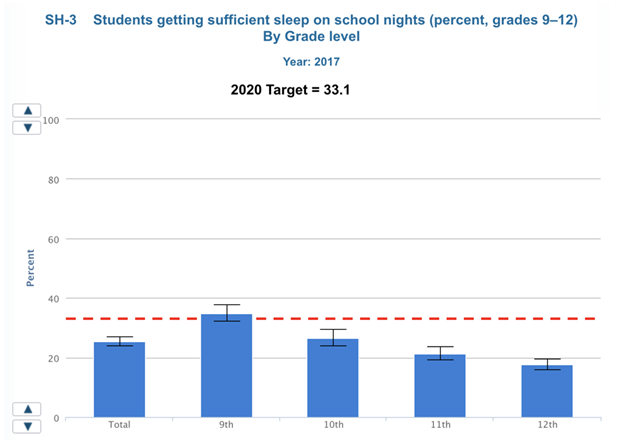Introduction
Poor sleep is a health issue that affects children, adolescents, and adults, with insufficient rest contributing to various physical and emotional health issues. Due to this, increasing public knowledge of how sleep improvement can improve health, wellness, productivity, and life quality is among the Healthy People 2020 goals. Sleep is seen as a critical determinant of well-being in the plan because its absence can lead to the development of problems in productivity, interpersonal relationships, mental health, and physical stability. In this paper, the topic of sleep health will be explored in great detail, with particular attention placed on the needs of the target population, the exploration of demographic and epidemiologic data, as well as the identification of interventions that would improve sleep health.
Target Population
The target population of adolescents and young adults at Downers Grove, IL, is chosen for the present exploration as they are greatly affected by inadequate sleep. The population is more vulnerable to chronic sleep deficiency compared to adults as reported by Zitting et al. (2018). Poor sleep in the group adolescent individuals and young adults has been reported worldwide, as evidenced in the study by Bruce, Lunt, and McDonagh (2017) who investigated the issue in the UK context.
It was found that 30% of males and 49% of females in the group reported sleep issues and the subsequent difficulties related to concentration on school and work (Bruce et al., 2017, p. 425). The increased issues with sleep health have been attributed to the reduced urge to fall asleep in adolescents linked to a biological delay in the timing of sleep onset (Bruce et al,. 2017). However, the need to rise early for school remains constant, which creates issues with tiredness during the day.
Healthy People 2020 Goals and Objectives
As stated in the Healthy People 2020 component associated with sleep health, the burden of chronic sleep loss and sleep disorders deteriorates due to the decreased awareness of the public, health care professionals, and policymakers (Healthy People 2020, 2020).
Thus, the goal of the program is to increase the awareness of the mentioned groups of how the achievement of adequate sleep can improve the overall health of the population as well as facilitate safety in the workplace and such public areas as roads. There are four distinct objectives established for the Healthy People 2020 sleep health program. The first objective is to increase the number of people with obstructive sleep apnea who seek medical attention. The second is to reduce the rate of drowsy driving-related vehicular crashes per 100 miles. The third is to increase the percentage of students in grades 9-12 who get enough sleep (Figure 1). The fourth is to increase the rate of adults who get enough sleep.

Sleep Health Interventions
The overall improvement of sleep health among the target population has been explored from the perspective of interventions. For example, as proposed by Jespersen, Koenig, Jennum, and Vuust (2015), music can be used as a tool to help adults decrease the occurrence of insomnia. According to the researchers, randomized and quasi-randomized controlled trials showed that listening to music with “no treatment or treatment-as-usual” can improve sleep health in adults struggling with insomnia (Jespersen et al., 2015, p. 1). Interventions that use music to facilitate better sleep are easy to implement and can facilitate the improvement of the overall well-being of adolescents and young people who do not get enough sleep.
Another intervention for improving sleep health was proposed by John, Bellipady, and Bhat (2016), who developed a set of sleep promotion sessions for the target population. For two days, the subjects of intervention were expected to participate in visualization training, which implied “a video-based training using imagery for stress reduction and relaxation” (John et al., 2016, p. 2). Furthermore, the participants would be given tips for time management in order to be equipped with full information on how to deal with insufficient sleep.
Such an intervention provides a multi-dimensional approach toward sleep management and offers people an opportunity to be better at managing their time and relaxing before falling asleep. The target population can easily follow the stress reduction procedures recommended during training sessions and thus improve their capacity of falling asleep.
Conclusion
The issue of poor sleep health affects adolescents and young adults because of the biological delays occurring in the timing of sleep onset, causing them to stay awake later (Bruce et al., 2017). Due to such a change, maintaining the health of this target population is imperative as it presents significant challenges to well-being. The Healthy People 2020 plan associated with sleep health intends to facilitate the improvement of the issue with the help of cohesive interventions.
For adolescents and young adults, holistic programs represent the basis for health improvement. Using relaxation techniques is recommended to help individuals struggling with poor sleep to get into a mindset of rest and decrease worrying and anxiety. However, interventions intended to improve sleep health are currently limited, which points to the need to study the issue further, with special focus placed on adolescents and young adults.
References
Bruce, E. S., Lunt, L., & McDonagh, J. E. (2017). Sleep in adolescents and young adults. Clinical Medicine, 17(5), 424-428.
Healthy People 2020. (2020). Sleep health. Web.
Jespersen, K., Koenig, J., & Vuust, P. (2015). Music for insomnia in adults. Cochrane Systematic Review – Intervention. Web.
John, B., Bellipady, S. S., & Bhat, S. U. (2016). Sleep promotion program for improving sleep behaviors in adolescents: A randomized controlled pilot study. Scientifica, 2016, 8013431.
Zitting, K. M., Münch, M. Y., Cain, S. W., Wang, W., Wong, A., Ronda, J. M., … Duffy, J. F. (2018). Young adults are more vulnerable to chronic sleep deficiency and recurrent circadian disruption than older adults. Scientific Reports, 8(1), 11052.